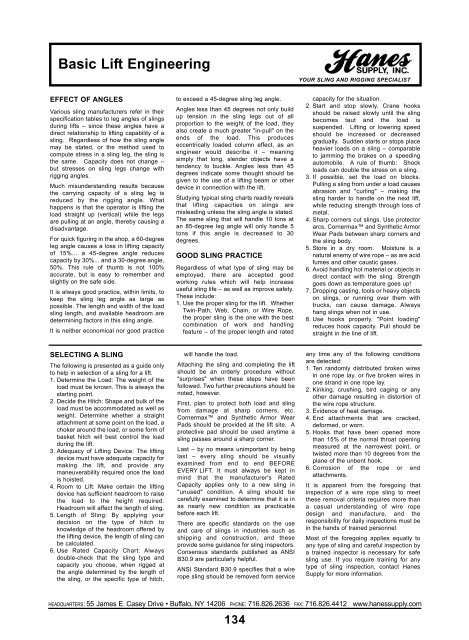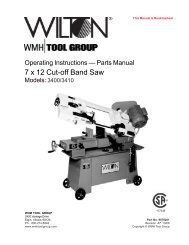This Rigger's Handbook is dedicated to Theodore C - Igor Chudov
This Rigger's Handbook is dedicated to Theodore C - Igor Chudov
This Rigger's Handbook is dedicated to Theodore C - Igor Chudov
You also want an ePaper? Increase the reach of your titles
YUMPU automatically turns print PDFs into web optimized ePapers that Google loves.
Basic Lift Engineering<br />
EFFECT OF ANGLES<br />
Various sling manufacturers refer in their<br />
specification tables <strong>to</strong> leg angles of slings<br />
during lifts – since these angles have a<br />
direct relationship <strong>to</strong> lifting capability of a<br />
sling. Regardless of how the sling angle<br />
may be stated, or the method used <strong>to</strong><br />
compute stress in a sling leg, the sling <strong>is</strong><br />
the same. Capacity does not change –<br />
but stresses on sling legs change with<br />
rigging angles.<br />
Much m<strong>is</strong>understanding results because<br />
the carrying capacity of a sling leg <strong>is</strong><br />
reduced by the rigging angle. What<br />
happens <strong>is</strong> that the opera<strong>to</strong>r <strong>is</strong> lifting the<br />
load straight up (vertical) while the legs<br />
are pulling at an angle, thereby causing a<br />
d<strong>is</strong>advantage.<br />
For quick figuring in the shop, a 60-degree<br />
leg angle causes a loss in lifting capacity<br />
of 15%... a 45-degree angle reduces<br />
capacity by 30%... and a 30-degree angle,<br />
50%. <strong>Th<strong>is</strong></strong> rule of thumb <strong>is</strong> not 100%<br />
accurate, but <strong>is</strong> easy <strong>to</strong> remember and<br />
slightly on the safe side.<br />
It <strong>is</strong> always good practice, within limits, <strong>to</strong><br />
keep the sling leg angle as large as<br />
possible. The length and width of the load<br />
sling length, and available headroom are<br />
determining fac<strong>to</strong>rs in th<strong>is</strong> sling angle.<br />
It <strong>is</strong> neither economical nor good practice<br />
SELECTING A SLING<br />
The following <strong>is</strong> presented as a guide only<br />
<strong>to</strong> help in selection of a sling for a lift.<br />
1. Determine the Load: The weight of the<br />
load must be known. <strong>Th<strong>is</strong></strong> <strong>is</strong> always the<br />
starting point.<br />
2. Decide the Hitch: Shape and bulk of the<br />
load must be accommodated as well as<br />
weight. Determine whether a straight<br />
attachment at some point on the load, a<br />
choker around the load, or some form of<br />
basket hitch will best control the load<br />
during the lift.<br />
3. Adequacy of Lifting Device: The lifting<br />
device must have adequate capacity for<br />
making the lift, and provide any<br />
maneuverability required once the load<br />
<strong>is</strong> ho<strong>is</strong>ted.<br />
4. Room <strong>to</strong> Lift: Make certain the lifting<br />
device has sufficient headroom <strong>to</strong> ra<strong>is</strong>e<br />
the load <strong>to</strong> the height required.<br />
Headroom will affect the length of sling.<br />
5. Length of Sling: By applying your<br />
dec<strong>is</strong>ion on the type of hitch <strong>to</strong><br />
knowledge of the headroom offered by<br />
the lifting device, the length of sling can<br />
be calculated.<br />
6. Use Rated Capacity Chart: Always<br />
double-check that the sling type and<br />
capacity you choose, when rigged at<br />
the angle determined by the length of<br />
the sling, or the specific type of hitch,<br />
<strong>to</strong> exceed a 45-degree sling leg angle.<br />
Angles less than 45 degrees not only build<br />
up tension in the sling legs out of all<br />
proportion <strong>to</strong> the weight of the load, they<br />
also create a much greater "in-pull" on the<br />
ends of the load. <strong>Th<strong>is</strong></strong> produces<br />
eccentrically loaded column effect, as an<br />
engineer would describe it – meaning<br />
simply that long, slender objects have a<br />
tendency <strong>to</strong> buckle. Angles less than 45<br />
degrees indicate some thought should be<br />
given <strong>to</strong> the use of a lifting beam or other<br />
device in connection with the lift.<br />
Studying typical sling charts readily reveals<br />
that lifting capacities on slings are<br />
m<strong>is</strong>leading unless the sling angle <strong>is</strong> stated.<br />
The same sling that will handle 10 <strong>to</strong>ns at<br />
an 85-degree leg angle will only handle 5<br />
<strong>to</strong>ns if th<strong>is</strong> angle <strong>is</strong> decreased <strong>to</strong> 30<br />
degrees.<br />
GOOD SLING PRACTICE<br />
Regardless of what type of sling may be<br />
employed, there are accepted good<br />
working rules which will help increase<br />
useful sling life – as well as improve safety.<br />
These include:<br />
1. Use the proper sling for the lift. Whether<br />
Twin-Path, Web, Chain, or Wire Rope,<br />
the proper sling <strong>is</strong> the one with the best<br />
combination of work and handling<br />
feature – of the proper length and rated<br />
will handle the load.<br />
Attaching the sling and completing the lift<br />
should be an orderly procedure without<br />
"surpr<strong>is</strong>es" when these steps have been<br />
followed. Two further precautions should be<br />
noted, however.<br />
First, plan <strong>to</strong> protect both load and sling<br />
from damage at sharp corners, etc.<br />
Cornermax and Synthetic Armor Wear<br />
Pads should be provided at the lift site. A<br />
protective pad should be used anytime a<br />
sling passes around a sharp corner.<br />
Last – by no means unimportant by being<br />
last – every sling should be v<strong>is</strong>ually<br />
examined from end <strong>to</strong> end BEFORE<br />
EVERY LIFT. It must always be kept in<br />
mind that the manufacturer's Rated<br />
Capacity applies only <strong>to</strong> a new sling in<br />
"unused" condition. A sling should be<br />
carefully examined <strong>to</strong> determine that it <strong>is</strong> in<br />
as nearly new condition as practicable<br />
before each lift.<br />
There are specific standards on the use<br />
and care of slings in industries such as<br />
shipping and construction, and these<br />
provide some guidance for sling inspec<strong>to</strong>rs.<br />
Consensus standards publ<strong>is</strong>hed as ANSI<br />
B30.9 are particularly helpful.<br />
ANSI Standard B30.9 specifies that a wire<br />
rope sling should be removed form service<br />
HEADQUARTERS: 55 James E. Casey Drive • Buffalo, NY 14206 PHONE: 716.826.2636 FAX: 716.826.4412 www.hanessupply.com<br />
134<br />
YOUR SLING AND RIGGING SPECIALIST<br />
capacity for the situation.<br />
2. Start and s<strong>to</strong>p slowly. Crane hooks<br />
should be ra<strong>is</strong>ed slowly until the sling<br />
becomes taut and the load <strong>is</strong><br />
suspended. Lifting or lowering speed<br />
should be increased or decreased<br />
gradually. Sudden starts or s<strong>to</strong>ps place<br />
heavier loads on a sling – comparable<br />
<strong>to</strong> jamming the brakes on a speeding<br />
au<strong>to</strong>mobile. A rule of thumb: Shock<br />
loads can double the stress on a sling.<br />
3. If possible, set the load on blocks.<br />
Pulling a sling from under a load causes<br />
abrasion and "curling" – making the<br />
sling harder <strong>to</strong> handle on the next lift,<br />
while reducing strength through loss of<br />
metal.<br />
4. Sharp corners cut slings. Use protec<strong>to</strong>r<br />
arcs, Cornermax and Synthetic Armor<br />
Wear Pads between sharp corners and<br />
the sling body.<br />
5. S<strong>to</strong>re in a dry room. Mo<strong>is</strong>ture <strong>is</strong> a<br />
natural enemy of wire rope – as are acid<br />
fumes and other caustic gases.<br />
6. Avoid handling hot material or objects in<br />
direct contact with the sling. Strength<br />
goes down as temperature goes up!<br />
7. Dropping casting, <strong>to</strong>ols or heavy objects<br />
on slings, or running over them with<br />
trucks, can cause damage. Always<br />
hang slings when not in use.<br />
8. Use hooks properly. "Point loading"<br />
reduces hook capacity. Pull should be<br />
straight in the line of lift.<br />
any time any of the following conditions<br />
are detected:<br />
1. Ten randomly d<strong>is</strong>tributed broken wires<br />
in one rope lay, or five broken wires in<br />
one strand in one rope lay.<br />
2. Kinking, crushing, bird caging or any<br />
other damage resulting in d<strong>is</strong><strong>to</strong>rtion of<br />
the wire rope structure.<br />
3. Evidence of heat damage.<br />
4. End attachments that are cracked,<br />
deformed, or worn.<br />
5. Hooks that have been opened more<br />
than 15% of the normal throat opening<br />
measured at the narrowest point, or<br />
tw<strong>is</strong>ted more than 10 degrees from the<br />
plane of the unbent hook.<br />
6. Corrosion of the rope or end<br />
attachments.<br />
It <strong>is</strong> apparent from the foregoing that<br />
inspection of a wire rope sling <strong>to</strong> meet<br />
these removal criteria requires more than<br />
a casual understanding of wire rope<br />
design and manufacture, and the<br />
responsibility for daily inspections must be<br />
in the hands of trained personnel.<br />
Most of the foregoing applies equally <strong>to</strong><br />
any type of sling and careful inspection by<br />
a trained inspec<strong>to</strong>r <strong>is</strong> necessary for safe<br />
sling use. If you require training for any<br />
type of sling inspection, contact Hanes<br />
Supply for more information.
















